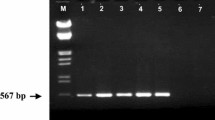Summary
Forty-four landraces of Portuguese coles (Brassica oleracea L.), representing different morphotypes, were screened at the cotyledon stage for downy mildew resistance, caused by Peronospora parasitica. Two isolates of the pathogen, PHW 630 and PHW 828, were used in the experiment. The mean disease interaction phenotype varied among the landraces. Overall, the Portuguese coles have shown resistance to both isolates, particularly to isolate PHW 828. Some landraces were identified with differential reaction to the two P. parasitica isolates. Some of the Portuguese coles are, therefore, good sources of resistance genes to P. parasitica, and could be used in breeding programs or in the development of a downy mildew host differential set. Among the morphotypes tested, Couve Algarvia (ISA 207), Couve Galega (ISA 243 and 187) and Couve Glória de Portugal (ISA 84) have presented the highest resistance interaction. For the development of host differential sets, the landraces ISA 2 (Penca de Mirandela), ISA 35 (Couve de Valhascos) and ISA 600 (Penca Espanhola) could be further selected for the differentiation of P. parasitica isolates. They are resistant to PHW 828 and susceptible to PHW 643.
The same morphotypes and landraces were also screened at the seedling stage for resistance to clubroot, caused by Plasmodiophora brassicae Woron.. Although some variation for resistance could be noticed in some the landraces tested, mainly Galega kale types, none of them presented a sufficient level of resistance as to be directly be useful in breeding for resistance to race 6 of P. brassicae.
Similar content being viewed by others
References
Crute, I.R., K.Phelps, A.Barnes, S.T.Buczacki & P.Crisp, 1983. The relationship between genotypes of three Brassica species and collections of Plasmodiophora brassicae. Plant Pathology, 32: 405–420.
Dias, J.S., 1992. Taxonomia das Couves Galaico-Portuguesas Utilizando Caracteres Morfológicos, Isoenzimas e RFLPs. PhD thesis. Universidade Técnica de Lisboa. Lisboa. 181 pp. (in Portuguese)
Dias, J.S., M.B.Lima, K.M.Song, A.A.Monteiro, P.W.Williams & T.C.Osborn, 1992. Molecular taxonomy of Portuguese tronchuda cabbage and kale landraces using nuclear RFLPs. Euphytica 58: 221–229.
Ferreira, M.E., J.S. Dias, A. Mengistu & P.W. Williams, 1993. Screening of Portuguese cole landraces (Brassica oleracea L.) with Leptosphaeria maculans and Xanthomonas campestris pv. campestris. Euphytica (in press).
Monteiro, A.A. & P.W.Williams, 1989. The exploration of genetic resources of Portuguese cabbage and kale for resistance to several Brassica diseases. Euphytica, 41: 215–225.
Nelder, J.A. & R.W.M.Wedderburn, 1972. Generalized linear models. J R Statist Soc A 135(3): 370–381.
Walker, J.C. & P.H. Williams, 1977. Crucifers. In: Breeding Plants for Diseases Resistance Concepts and Applications. Ed. by R.R. Nelson. Penn. St. Univ. Press. University Park. pp. 307–325.
Williams, P.H., 1966. A system for the determination of races of Plasmodiophora brassicae that infect cabbage and rutabaga. Phytopathology 56(6): 624–626.
Williams, P.H., 1985. CrGC Resource Book. Department of Plant Pathology. University of Wisconsin, Madison, WI, USA.
Author information
Authors and Affiliations
Rights and permissions
About this article
Cite this article
Dias, J.S., Ferreira, M.E. & Williams, P.H. Screening of Portuguese cole landraces (Brassica oleracea L.) with Peronospora parasitica and Plasmodiophora brassicae . Euphytica 67, 135–141 (1993). https://doi.org/10.1007/BF00022736
Received:
Accepted:
Issue Date:
DOI: https://doi.org/10.1007/BF00022736




